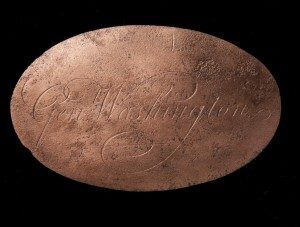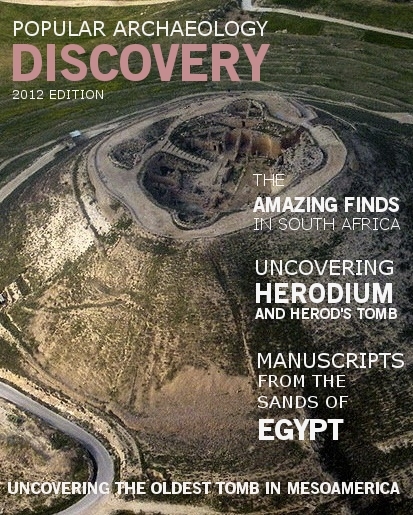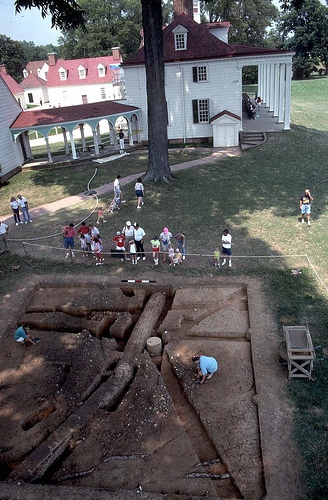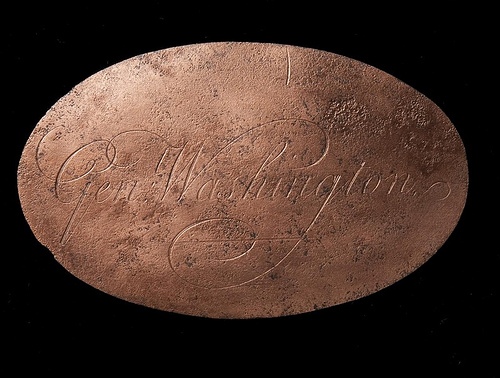
Most people wouldn’t even think about an 18th century refuse pit. But for archaeologists, it can be a veritable goldmine of information about the past. And for archaeological investigators at George Washington’s Mount Vernon home and estate near the Virginia banks of the Potomac river in 1990, no pile of garbage was as precious as the one located just south of the famous restored mansion house in the area historically known as the south grove.
Designated the South Grove Midden (a “midden” in archaeological parlance is another name for a trash dump), clues of its existence actually first emerged in 1948, when members of the Mount Vernon grounds crew excavated a hole in the area to plant a holly tree. A number of artifacts dating to the eighteenth century were recovered, telltale clues that the south grove area could be the location of midden deposits formed during George Washington’s lifetime. This would be no surprise, as the area was near the Washington household kitchen and it was common in the 18th century to dispose of household refuse near where it was generated. Spots not far from the back doors of kitchens were considered prime dumping grounds back then.
But it wasn’t until 1990 when archaeologists began to seriously focus on the spot, after a grounds crew again encountered historic deposits while constructing an irrigation system. From 1990 through 1994, full-scale excavations (see image right) recovered nearly 300,000 artifacts, an unprecedented array of household items deposited by the Washington family and enslaved families over several decades in the 18th century.
“The South Grove Midden collection represents the largest and most significant collection of artifacts excavated to date associated with the domestic lives of the Washington households,” says Eleanor Breen, Deputy Director of Archaeology at Mount Vernon. “One evocative artifact after another – from the unique to the prosaic – tells the interconnected stories of Mount Vernon plantation’s earliest residents: Lawrence and Anne Fairfax Washington; George Washington in his bachelorhood and as a newlywed; and the enslaved Africans and African Americans who labored in the mansion and outbuildings.”
Thus as any archaeologist would say, the artifacts in themselves are not the real treasure. It is the information that can be gleaned from them. The South Grove Midden artifacts have afforded scholars and the public alike with a remarkable window on life on George Washington’s estate during the period of its occupation by the Washington family from about 1735 to 1858, and evidence of activities there before and after that period.
Nothing spoke to this more when, in January 2013, the most significant finds were highlighted in a searchable online database of no less than 711 key objects, including photographs, detailed summaries, and catalogue information, all interfaced with documentary and thematic material information that in essence makes them accessible to any visitor. But, says Breen, “the Mount Vernon Midden website is more than an e-museum, it’s a digital humanities effort to present the individual artifacts in layers of both archaeological and historical context.”
“In envisioning and designing the website with Mark Freeman of Stories Past, our goal was to reach a broad audience – from the archaeology enthusiast to the scholar of material culture. The website is structured like a pyramid with the individual object catalogue records at the top (with professional quality photographs that can be zoomed in on for greater detail and unique narrative text explaining the significance of the artifact), more extensive content in the middle (in the form of summaries of artifact sub-assemblages and thematic essays on groupings of artifacts), and the complete artifact catalogue at the base (accessed via www.daacs.org).”
To give an example of just one individual object record, one artifact, known to archaeological enthusiasts and scholars of George Washington as the George Washington trunk plate, is pictured at the website as object no. 2921. It represents both an affirmation of the historicity of George Washington’s experience during the Revolutionary War as well as tangible material witness to his genteel status in 18th century American society:
________________________________________________________________________________________________________________________
[Recovered from the South Grove Midden] This oval copper alloy plate, engraved “Gen: Washington,” is identical to a plate affixed to a trunk in the Mount Vernon collection which George Washington is known to have purchased secondhand on April 4, 1776, in Boston, soon after he took up his duties as general of the Continental Army. The plate on the trunk was placed over the initials of the previous owner, a Boston merchant named John Head. Throughout the Revolutionary War, the security of his official correspondence and orders was a perpetual concern for General George Washington. In the intervening weeks between the British evacuation of Boston and his departure to defend Manhattan, Washington obtained the travelling trunk to contain the increasing number of official papers in his possession. The trunk was part of General Washington’s baggage throughout the war, returning with him to Mount Vernon when he retired from military service in 1783. Given the similarity of the two specimens, the excavated plate almost surely had the same origin. The original trunk was made of rawhide, wood, leather and lined with linen. Only the metal hardware (tacks, hinges, and this plate) would survive archaeologically.
This is one of the few artifacts that we have found with George Washington’s name engraved upon it. The other object excavated from the South Grove Midden that can be linked directly back to Washington is the fragment of a silver scabbard collar engraved with part of his monogram (2696). Wine bottle seals with the crest, name, or initials of their past owners are encountered in the archaeological record at Mount Vernon and on other historic sites of the colonial period; however, it appears that George Washington did not have his own. The significance of these formally marked objects relates to an expression of gentility and status. For example, pewter dishes were widely available in the eighteenth century to consumers. However, a simple pewter plate could be elevated and distinguished with the placement of a family crest, as George Washington requested be done on a set of 96 pewter dishes in 1759.
— Object Detail from the Mount Vernon Midden Project website.
Photo courtesy Mount Vernon Preservation.
________________________________________________________________________________________________________________________
“Other artifacts excavated from the soil layers of the midden give us pause to consider how Lawrence and George Washington and other elite planters afforded this burgeoning genteel lifestyle,” adds Breen. “A singular artifact called a denier gauge [pictured as object no. 2922 in the database], a small magnifying glass that counted threads per quarter inch of cloth, focuses our attention on the enslaved men and women upon whose labor refined styles of life were based. At the beginning of Washington’s tenure at Mount Vernon, he oversaw approximately 30 Africans and Afro-Virginians, a community whose numbers would increase to over 300 at the time of Washington’s death in 1799. These enslaved individuals worked for the profit of their owners plowing the fields, forging the iron, cooking the meals, and sewing or weaving the cloth – the quality of which was measured and checked by Martha Washington using the denier gauge.”
The database contains much more than objects excavated from the Midden. Also documented are 3,839 invoices and orders, described through both picture and narrative. They constitute the record of his economic life before the Revolutionary War, from 1754 to 1773, including items such as fabrics, seeds, medicines, shoes, foodstuffs, and plantation tools shipped to him on a total of 26 vessels during that time period. Along with the other objects, Mount Vernon archaeologists say that these invoices and orders have helped, and will continue to be a key, to improving our understanding of material culture, consumerism, and economics during 18th century colonial America.
“The South Grove Midden and associated documentary evidence in the form of George Washington’s orders for goods from England and inventories of a local store in the town of Colchester provides the opportunity to study a dynamic period in American history,” says Breen. “What makes the 40-year period before the American Revolution unique is that access to consumer goods appears to have opened up for larger segments of the colonial population through a more sophisticated and far-reaching system of distribution for imported items – an event described as the consumer revolution. The artifacts and documents associated with the site offer an opportunity to explore this transformation through material culture.”
Anyone can access and explore the database by going to mountvernonmidden.org.
________________________________
All images courtesy Mount Vernon Ladies Association, Mount Vernon Department of Archaeology, and Mount Vernon Preservation.
_______________________________________________________________________________________________________________________________________________
Read about the most fascinating discoveries with a premium subscription to Popular Archaeology Magazine. Find out what Popular Archaeology Magazine is all about. AND MORE:
 Popular Archaeology’s annual Discovery edition is a selection of the best stories published in Popular Archaeology Magazine in past issues, with an emphasis on some of the most significant, groundbreaking, or fascinating discoveries in the fields of archaeology and paleoanthropology and related fields. At least some of the articles have been updated or revised specifically for the Discovery edition. We can confidently say that there is no other single issue of an archaeology-related magazine, paper print or online, that contains as much major feature article content as this one. The latest issue, volume 2, has just been released. Go to the Discovery edition page for more information.
Popular Archaeology’s annual Discovery edition is a selection of the best stories published in Popular Archaeology Magazine in past issues, with an emphasis on some of the most significant, groundbreaking, or fascinating discoveries in the fields of archaeology and paleoanthropology and related fields. At least some of the articles have been updated or revised specifically for the Discovery edition. We can confidently say that there is no other single issue of an archaeology-related magazine, paper print or online, that contains as much major feature article content as this one. The latest issue, volume 2, has just been released. Go to the Discovery edition page for more information.
Subscription Price: A very affordable $5.75 for those who are not already premium subscribers of Popular Archaeology Magazine (It is FREE for premium subscribers to Popular Archaeology). Premium subscribers should email populararchaeology@gmail.com and request the special coupon code. Or, for the e-Book version, it can be purchased for only $3.99 at Amazon.com.




